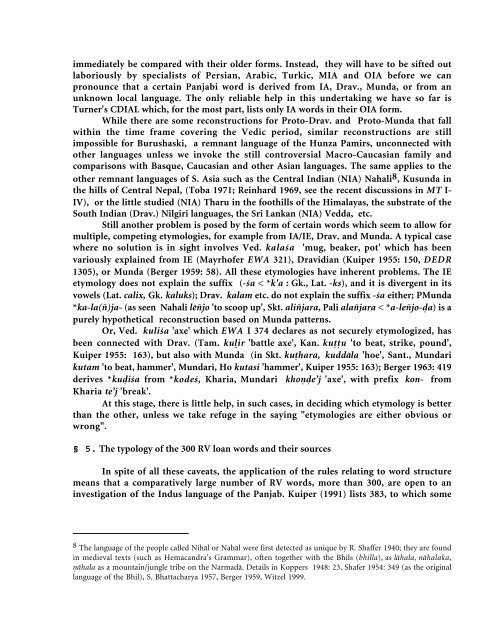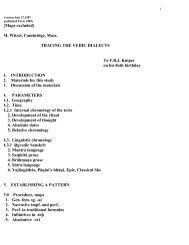The Languages of Harappa - People Fas Harvard
The Languages of Harappa - People Fas Harvard
The Languages of Harappa - People Fas Harvard
You also want an ePaper? Increase the reach of your titles
YUMPU automatically turns print PDFs into web optimized ePapers that Google loves.
immediately be compared with their older forms. Instead, they will have to be sifted out<br />
laboriously by specialists <strong>of</strong> Persian, Arabic, Turkic, MIA and OIA before we can<br />
pronounce that a certain Panjabi word is derived from IA, Drav., Munda, or from an<br />
unknown local language. <strong>The</strong> only reliable help in this undertaking we have so far is<br />
Turner's CDIAL which, for the most part, lists only IA words in their OIA form.<br />
While there are some reconstructions for Proto-Drav. and Proto-Munda that fall<br />
within the time frame covering the Vedic period, similar reconstructions are still<br />
impossible for Burushaski, a remnant language <strong>of</strong> the Hunza Pamirs, unconnected with<br />
other languages unless we invoke the still controversial Macro-Caucasian family and<br />
comparisons with Basque, Caucasian and other Asian languages. <strong>The</strong> same applies to the<br />
other remnant languages <strong>of</strong> S. Asia such as the Central Indian (NIA) Nahali 8 , Kusunda in<br />
the hills <strong>of</strong> Central Nepal, (Toba 1971; Reinhard 1969, see the recent discussions in MT I-<br />
IV), or the little studied (NIA) Tharu in the foothills <strong>of</strong> the Himalayas, the substrate <strong>of</strong> the<br />
South Indian (Drav.) Nilgiri languages, the Sri Lankan (NIA) Vedda, etc.<br />
Still another problem is posed by the form <strong>of</strong> certain words which seem to allow for<br />
multiple, competing etymologies, for example from IA/IE, Drav. and Munda. A typical case<br />
where no solution is in sight involves Ved. kalaśa 'mug, beaker, pot' which has been<br />
variously explained from IE (Mayrh<strong>of</strong>er EWA 321), Dravidian (Kuiper 1955: 150, DEDR<br />
1305), or Munda (Berger 1959: 58). All these etymologies have inherent problems. <strong>The</strong> IE<br />
etymology does not explain the suffix (-śa < *k'a : Gk., Lat. -ks), and it is divergent in its<br />
vowels (Lat. calix, Gk. kaluks); Drav. kalam etc. do not explain the suffix -śa either; PMunda<br />
*ka-la(ñ)ja- (as seen Nahali lẽñjo 'to scoop up', Skt. aliñjara, Pali alañjara < *a-leñjo-a) is a<br />
purely hypothetical reconstruction based on Munda patterns.<br />
Or, Ved. kuliśa 'axe' which EWA I 374 declares as not securely etymologized, has<br />
been connected with Drav. (Tam. kuir 'battle axe', Kan. kuu 'to beat, strike, pound',<br />
Kuiper 1955: 163), but also with Munda (in Skt. kuhara, kuddåla 'hoe', Sant., Mundari<br />
kutam 'to beat, hammer', Mundari, Ho kutasi 'hammer', Kuiper 1955: 163); Berger 1963: 419<br />
derives *kuiśa from *kodeś, Kharia, Mundari khoe’j 'axe', with prefix kon- from<br />
Kharia te’j 'break'.<br />
At this stage, there is little help, in such cases, in deciding which etymology is better<br />
than the other, unless we take refuge in the saying "etymologies are either obvious or<br />
wrong".<br />
§ 5. <strong>The</strong> typology <strong>of</strong> the 300 RV loan words and their sources<br />
In spite <strong>of</strong> all these caveats, the application <strong>of</strong> the rules relating to word structure<br />
means that a comparatively large number <strong>of</strong> RV words, more than 300, are open to an<br />
investigation <strong>of</strong> the Indus language <strong>of</strong> the Panjab. Kuiper (1991) lists 383, to which some<br />
8 <strong>The</strong> language <strong>of</strong> the people called Nihål or Nahål were first detected as unique by R. Shaffer 1940; they are found<br />
in medieval texts (such as Hemacandra's Grammar), <strong>of</strong>ten together with the Bhils (bhilla), as låhala, nåhalaka,<br />
åhala as a mountain/jungle tribe on the Narmadå. Details in Koppers 1948: 23, Shafer 1954: 349 (as the original<br />
language <strong>of</strong> the Bhil), S. Bhattacharya 1957, Berger 1959, Witzel 1999.

















